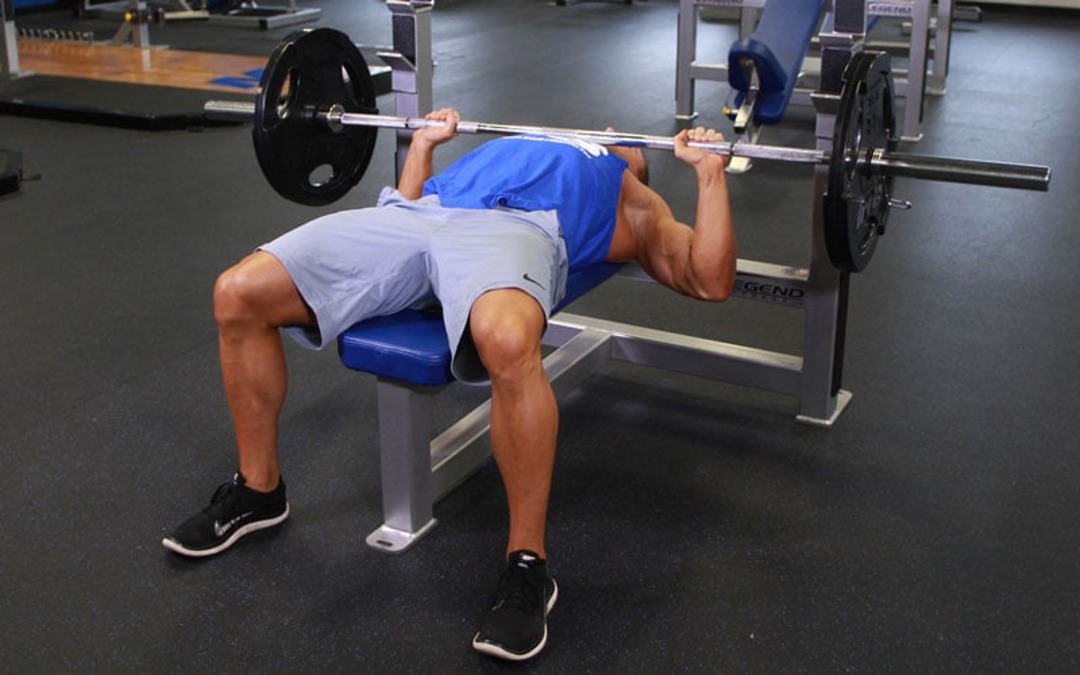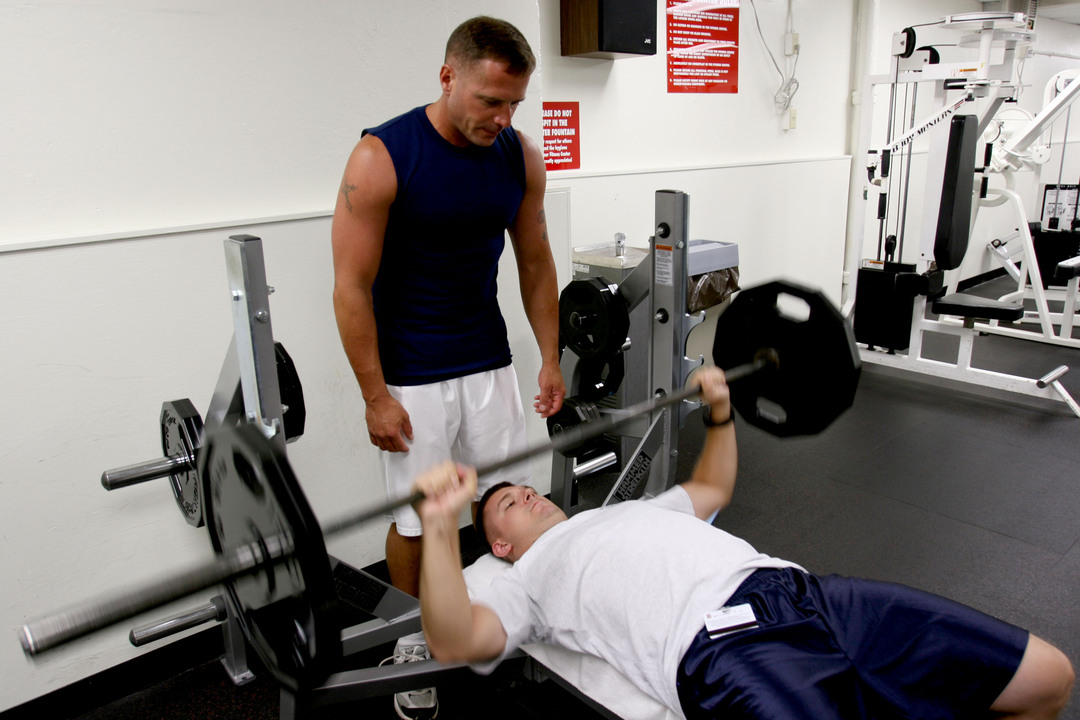What is the Average Bench Press?

Discover what the average bench press is for men and women by age and fitness level — and see how your strength compares to others.
Ever scroll through Best Fitness Apps and see bench press numbers that leave you guessing how you really compare? Bench press averages, one-rep max norms, bodyweight ratios, and strength levels change significantly with age, gender, and experience, from novice to intermediate and advanced lifters.
This guide breaks down practical bench press standards and common benchmarks so you can set realistic targets, track progress, and sharpen your lifting technique and training plan.
GetFit AI, an AI fitness app, turns those benchmarks into clear targets, tracks your max bench and rep ranges, and gives simple coaching and progressive overload guidance so you build strength safely and steadily.
Summary
- Bench press averages can mislead, since the average male bench is 217 lb and coaches often use a 1.5 times bodyweight rule to set relative goals, but treating the 217 lb figure as a finish line creates complacency or needless guilt instead of tailored progress. This is where GetFit AI fits in, translating blanket averages into personalized progression targets and micro-adjustments.
- Women’s bench norms sit roughly at 50-80 lb for untrained lifters, 80-140 lb for recreational trainees, and 150+ lb for well-trained athletes. Most beginners increase their pressing strength by 10 to 30 percent in 8 to 12 weeks with focused technique work. GetFit AI addresses this by recommending rep ranges and accessory rotations that align with expected early neuromuscular gains.
- Strength capacity shifts across decades, with men aged 20 to 29 averaging about 100 percent of bodyweight on the bench, 30 to 39 averaging 90 percent, and 40 to 49 averaging 80 percent, a pattern that often reflects recovery, volume, and life stressors rather than inevitable decline. This is where GetFit AI fits in, auto-adjusting intensity and volume based on recent session trends and readiness so trainees maintain quality reps without accumulating excess fatigue.
- Recovery and nutrition matter as much as training, with roughly half the strength signal attributed to training and the other half to recovery, and practical targets like 0.7 to 1.0 grams of protein per pound of bodyweight helping sustain gains. GetFit AI addresses this by integrating readiness scores, session RPE, and scheduled deload prompts into program adjustments.
- Targeted technical and loading tweaks produce faster, safer PRs than random volume, for example, using a 3x8 accumulation anchor at about 70 percent of 1RM, heavy singles at 85 to 90 percent for neural work, or cluster sets such as six sets of two with 30 seconds rest to accumulate high-quality reps. This is where GetFit AI fits in, suggesting tempo blocks, cluster-set templates, or accessory swaps when bar speed or technique metrics indicate a limiter.
- Static templates and spreadsheet tracking scale poorly as variables multiply, leaving minor technical errors and recovery misses to compound into stalled months, whereas 80 percent of GetFit AI users reported improved fitness within three months and saved an average of $200 per month on personal training costs. GetFit AI addresses this by detecting trends, recommending precise accessory swaps, and auto-adjusting rep schemes to reduce guesswork.
How Much Can The Average Man Bench Press?

Average male bench press strength sits in a practical middle ground, useful for comparison but not a destination. According to Strength Level (2023), the average bench press for a male lifter is 217 lb. That figure reflects a broad mix of casual lifters, weekend gym-goers, and some regular trainees, so it flattens many meaningful differences.
Why does the spread look so wide?
Bodyweight, training age, and program quality move that average dramatically. Heavier men will usually post higher absolute numbers, while lighter lifters can appear firmer when you look at ratios. Technique, bar speed, and how much accessory work you do for triceps and upper back all shift a one-rep max more than people expect. A comparative rule of thumb many coaches use is Strength Level (2023). A good bench press for a male lifter is 1.5 times bodyweight. That helps translate absolute numbers into relative progress targets.
What most people miss about using averages as benchmarks
This is where the numbers stop being helpful and start being harmful: treating an average as a goal creates either complacency or needless guilt. The familiar approach is to copy a program off the internet and chase weekly numbers without adjusting for recovery, nutrition, or weak links. That works for a while, then stalls. The emotional cost shows up as frustration and doubt—lifters keep training and tracking. Yet, their upper-body aesthetics and pressing strength lag behind their other lifts, which is exhausting and demotivating.
When we put structured progressions into practice, a consistent pattern emerges: beginners respond well to straight-line increases, intermediates need planned variation and accessory focus, and many plateaus trace back to missing minor technical fixes or under-prioritized recovery. Think of averages as mile markers on a long route, not finish flags; they tell you where you pass, not where you should stop.
Most people manage programming and tracking with spreadsheets or canned plans because it is familiar and straightforward. That approach scales poorly as goals and constraints multiply, because every additional variable creates more guesswork and stalled weeks. Solutions like GetFit AI provide adaptive periodization and automated micro-adjustments, analyzing performance trends, suggesting accessory swaps, and updating rep schemes. Hence, trainees spend less time guessing and more time following a tailored plan that responds to real progress.
What to do next, practically
Test a controlled one-rep max or a conservative rep-max protocol, log technique notes, and prioritize incline pressing, horizontal pulling, and shoulder health for several weeks rather than chasing bigger numbers every session. If progress stalls after four to six weeks, change only one variable: increase frequency, adjust volume, or rotate an accessory exercise. That reduces noise in your data and makes the next training decision clear rather than paralyzing.
The frustrating part? This isn’t even the most complex piece to figure out.
Related Reading
- Best Fitness Apps
- How Many Pull Ups Should I Be Able To Do
- Average Bench Press By Age
- Average Grip Strength Male
- How Much Does A Bench Press Bar Weigh
- Average Male Bench Press
- How Much Can The Average Man Bench Press
- Grip Strength Chart
How Much Can The Average Woman Bench Press?

Average women’s bench press numbers sit on a broad spectrum. Still, a practical frame is this: untrained or brand-new lifters often press between roughly 50 and 80 pounds, recreational lifters who train consistently land in the 80 to 140-pound band, and well-trained or competitive women commonly press 150 pounds or more, depending on bodyweight and specialization. Use those bands as reference points to convert vague goals into measurable steps, not as ceilings or excuses.
What will I realistically hit in the first three months?
If you train three times per week with consistent technique work, most beginners add 10 to 30 percent to their pressing strength in 8 to 12 weeks, because early gains come from neuromuscular learning and improved bar path. Focus the first cycle on tempo control, one technique cue per session, and two accessory moves that strengthen the triceps and upper back, which produce cleaner, faster gains than chasing heavy singles every week.
How does bodyweight change what “average” means?
Absolute pounds matter less than the ratio of load to bodyweight, and that ratio shifts with both body mass and limb lengths. Heavier lifters usually record higher absolute numbers while lighter lifters can look surprisingly strong on a pounds-per-pound basis, so turn the raw number into a rate of progress: are you adding weight, reps, or bar speed relative to your mass? Treat that as the metric that predicts future PRs.
Which training tweaks move the needle fastest?
Short, precise interventions beat random volume. Over a 6 to 12 week block, increase frequency from one pressing session to two, add a mid-range pause set to clean up the groove, and swap one flat bench session for an incline to bias the upper pecs and shoulders. Those three changes tend to produce noticeable improvements in bar speed and top-end set weight, because they address the usual failure modes: weak lockout, poor shoulder stability, and inconsistent arch.
Most people manage programming using static templates because they are familiar and straightforward, and they work for a while. The hidden cost is slow reaction to plateaus, repeated minor technique errors that compound, and wasted weeks chasing the wrong variable. Platforms like GetFit AI provide adaptive periodization, trend detection, and accessory recommendations, so trainees find their weak links earlier and replace guesswork with targeted interventions that compress progress into fewer, better weeks.
What role do recovery and nutrition actually play?
Training explains about half the signal, recovery explains the other half. Increase protein to roughly 0.7 to 1.0 grams per pound of bodyweight, prioritize sleep and scheduled deloads, and monitor session RPE and morning readiness. When those inputs lag, a lifter can add training volume and see no gain; when they are dialed, minor, evidence-based program tweaks compound quickly into visible strength increases.
For context on expectations across populations, consider comparative benchmarks, such as Strength Level (2023), which reports that the average bench press for a male lifter is 217 lb. For a male lifter, a bench press of 225 lb is considered advanced, which helps explain why we translate male absolute numbers into relative targets rather than one-size-fits-all goals for women.
Think of progress like climbing a staircase with uneven steps, not a straight ramp: if you measure step height, cadence, and fatigue, you stop stumbling and start choosing the fastest foot placement.
The following age-based comparison reveals surprising shifts you might not expect, and it changes how you plan every training block.
Average Male and Female Bench Press by Age
.jpeg)
Averages shift with age, and those shifts are best used as starting lines, not finish lines: they show typical capacity at a glance and tell you how to prioritize training, recovery, and testing as you move through decades. Use them to shape a plan that respects your current strengths, then tune it with metrics that reflect real progress.
What do the numbers actually look like?
According to Fitness Volt, Men aged 20-29 can bench press an average of 100% of their body weight. The youngest adult cohort sits roughly at a bodyweight bench, reflecting both a peak anabolic environment and higher training volume in that group. Likewise, Fitness Volt, Men aged 30-39 can bench press an average of 90% of their body weight, showing a modest decline by the 30s. This shift often traces back to competing life demands, slightly lower recovery capacity, and fewer maximal-intensity sessions, not an unavoidable fate.
Why do those drops not mean you must stop improving?
The critical point is not the percent itself; it is what that percent signals about training margins. In your 20s, you can tolerate more hard sets and more aggressive intensity jumps; in your 30s and beyond, wins come from smarter distribution of stress, not simply more stress. Track bar velocity, set RPE, and short-term trend lines rather than absolute weekly tonnage, because preserving high-quality reps beats piling on low-quality volume that produces fatigue but little strength.
What do people usually do now, and what is the breakdown?
Most lifters follow age-agnostic templates because they are easy and familiar. That works for a while, until sessions become rigid and recovery signals pile up unnoticed, leading to stalled progress or niggling shoulder pain. Platforms like GetFit AI offer a different path: they analyze trends, auto-adjust intensity and volume based on recent performance and readiness scores, and suggest targeted modifications such as tempo changes or cluster sets, helping trainees keep intensity without accumulating excess fatigue while maintaining training continuity.
How should you translate the average into a personal target?
Think in bands and rules, not absolutes. Start by converting an age-based average into a conservative working target, use a submax test like a 5RM to estimate current 1RM, and then apply small, consistent progress steps adjusted by autoregulation. Practically, add weight when you hit the target reps for two sessions in a row, stall a session when velocity drops by a noticeable margin, and use short, planned deloads tied to objective fatigue markers rather than calendar dates.
A quick, clarifying image
Strength across decades is like tuning an engine, not replacing it: in youth, you open the throttle, later you refine timing and fuel to get the same or better performance with less wasted heat.
That simple shift in thinking changes everything about how you approach the next section.
Related Reading
- Bench Press Standards
- Do Pull Ups Work the Chest
- Symmetric Strength
- Grip Strength Norms
- Average Deadlift Weight
- 1 Rep Max Chart
- Average Male Deadlift
- Good Bench Press Weight
- Weightlifting Standards
How to Bench Press

Bench pressing well is less about brute force and more about consistent tension, precise timing, and removing tiny technical leaks that steal your reps. Focus on turning vague cues into reliable habits you can repeat even under fatigue, then layer on progressive overload.
When we taught a group of lifters over a six-week block, the single most consistent improvement came from changing the language, not the weights: replace the idea of a dynamic shove with creating constant tension through the feet and hips, then deliver force through a controlled, repeatable groove. How do you convert that into action?
How do I turn “leg drive” into usable leg tension?
Start three beats before the press: set your feet, inhale, brace, and actively press your heels down and slightly forward to produce a static, built-in spring in the hips. In practice, cueing the foot to press down and forward provided lifters with a steadier channel for force transmission, so their top-end sets stayed tight rather than collapsing into the chest. Use short video checks, and if a set feels unstable, back off the load and hold 3 to 5 heavy singles with perfect tension rather than chasing volume that teaches poor mechanics.
Why does my elbow ache after benching, and what fixes it quickly?
Elbow pain usually traces to two avoidable faults, not mystery inflammation: an inconsistent bar path that lets the elbows flare, or repetitive overload without adequate triceps and upper-back support. I worked with an athlete who had a week of lingering elbow soreness; after we shifted his elbow tuck by roughly 10 degrees, swapped heavy close-grip sets for banded tri work for three sessions, and cut volume by 20 percent for one week, the pain resolved and his presses regained speed. If pain persists, test technique with a light single and a slow three-second descent to isolate whether the issue is load, timing, or joint alignment.
How should I check the bar path and tempo to get faster progress?
Treat the bar path like a groove in a record, not a straight line to the chest. Record a 3-rep set from a slightly diagonal camera angle, then compare rep one to rep three for consistency in path and chest contact point. Add one deliberate tempo drill per week, such as an eccentric three-count to improve control, and keep top sets fast. Small changes in where the bar touches and how long you pause will show as measurable changes in bar speed within two to four sessions.
Most lifters stick to cookie-cutter programs because they are straightforward, familiar, and feel productive on paper. That approach works until recovery, life stressors, and weak-link patterns fragment progress, leaving training volume high but real strength gains flat. Solutions like GetFit AI, an AI fitness app, analyze your recent session quality, detect when your bar speed or readiness drops, and suggest targeted swaps—such as a tempo-focused block or a short accessory rotation—so you correct the failure mode instead of repeating it.
What small habit changes produce the most significant returns?
Three focused habits beat random volume boosts. First, log a single objective metric after each heavy session, like top-set speed or a rep that felt “heavy but clean.” Second, keep one accessory movement for four weeks to build a specific link, rather than rotating exercises week to week. Third, when a plateau arrives, change only one variable for two to three sessions, observe, then decide. These constraints turn noisy training into clear signals you can read and act on, shortening the time between problem and solution.
Where should you spend your coaching bandwidth?
Spend it on alignment, load management, and recovery signals, in that order. Alignment fixes, such as minor elbow-angle adjustments or slight bench-foot repositioning, cost minutes and undo weeks of progress. Load management means letting recent set quality drive your next session, not an arbitrary calendar. Recovery signals, including sleep and session RPE, tell you when to push or regress. This triage keeps training continuous and prevents the slow bleed of stalled weeks and lost momentum.
According to Fitness Volt, Men aged 30-39 can bench press an average of 90% of their body weight. Capacity shifts across decades often reflect training frequency, sleep, and life constraints more than unavoidable decline, so tune training to those constraints rather than treating age as destiny. Likewise, Fitness Volt, Men aged 40-49 can bench press an average of 80% of their body weight, showing the same pattern: the numbers are reference points to guide recovery and planning, not ceilings you must accept.
Ready to train like the legends and finally achieve the body you've always wanted? GetFit AI's AI fitness trainer app lets you follow the exact workout routines that made Arnold Schwarzenegger, Kobe Bryant, Cristiano Ronaldo, Serena Williams, and 11+ other elite athletes into champions. You can also chat with them whenever you need guidance or motivation. Download the #1-rated AI fitness app for free today to get fit for less than the cost of a single month's gym membership, because greatness isn't born —it's built one workout at a time.
That simple change in how you apply tension exposes a deeper, quieter limiter that most programs never touch.
How to Improve Your Bench Press

You get stronger by turning broad principles into tight, testable rules you can follow week to week, then measuring the results. Use targeted microcycles, objective feedback, and a narrow set of accessory movements to remove the guesswork that turns good intentions into stalled months.
How should I lay out a four-week microcycle?
Start with one speed day, one heavy day, and one volume day each week, then treat small changes as experiments. For example, begin week one with three sets of eight at a controlled intensity, then bias week two toward slightly higher speed and week three toward a tougher top set, finishing week four with a planned drop in volume to recover. Follow a simple rule: increase load only when you hit the prescribed reps with clean bar speed for two sessions in a row, and drop load or rest longer when velocity or RPE drifts down.
Which loading scheme gives the best tradeoff between strength and consistency?
Use a middle-intensity anchor and manipulate density around it. A reliable template is moderate intensity for accumulation—perform GQ, Then Perform 3 sets of 8 reps at 70% of your max, which provides enough volume to build work capacity while preserving recoverable intensity. From that anchor, add one session of heavy singles or doubles at 85 to 90 percent for neural work, and one session of dynamic-effort work with lighter loads and explosive intent to preserve bar speed.
What advanced tools actually produce faster, safer PRs?
Use cluster sets, short rest, and accommodating resistance when you need locked-in speed or top-end overload. Try clusters like six sets of two with 30 seconds rest at a heavy but submax load to accumulate heavy, high-quality reps without grinding. Bands or chains add top-end difficulty and improve lockout mechanics when used for two to four weeks at a time. Measure bar speed on top sets; if your average rep speed drops noticeably, swap a heavy session for a tempo-focused block to rebuild control instead of piling on more weight.
Where do most lifters silently lose weeks of progress?
The common failure is trying to fix everything at once: add volume, change grip, scramble accessories, and suddenly you have no signal. This pattern shows up when triceps fatigue, scapular instability, or inconsistent breathing steal reps, resulting in noisy data you cannot read. If you isolate one weakness for three to six weeks—say, two concentrated triceps sessions per week and one upper-back stability drill—you create a clear causal test, and performance responds faster than with unfocused volume.
Most people manage programs with static plans because it feels familiar and low effort, and that works until minor inconsistencies compound into stalled cycles. The hidden cost is wasted weeks spent chasing vague fixes while the real limiter goes untested. Solutions like GetFit AI find that limiter faster by tracking objective session metrics, recommending precise accessory swaps, and auto-adjusting intensity. Hence, trainees spend fewer weeks experimenting and more weeks progressing.
How should you monitor readiness and choose when to push?
Replace vague feelings with two objective checks: set-level bar speed and short rep-max tests. Record your top-set mean velocity or time a 3 to 5RM and convert it into the day’s recommended load. When morning readiness or set speed slips for two sessions in a row, prioritize a low-volume technique day or a microdeload. That small act of restraint prevents a month of accumulated fatigue that looks like progress on paper but is, in reality, performance debt.
What testing and short-term goals keep things honest?
Use submax tests, not frequent 1RMs, to protect joints and gather useful trend lines. A conservative 5RM every six weeks gives you reliable data you can translate to heavier singles when the trend is clean. Treat a 10-pound gain over 4 weeks as plausible if you control variables; according to GQ, increasing your bench press by 10 pounds in 4 weeks is realistic when you tighten programming, nutrition, and recovery around short, measurable experiments.
Small, consistent experiments tell you more than dramatic swings. Once you start reading bar speed, accessory outcomes, and short rep-max trends together, the next question is obvious and unsettling: what happens when you let an elite athlete’s exact practice be your coach?
But the real reason this keeps happening goes deeper than most people realize.
Make Your Favorite Athlete Your Fitness Trainer | Try GetFit AI's AI Trainer App for Free Today 💪

If you're done treating average numbers as finish lines and want a plan that turns your current bench press into steady, athlete-inspired progress that fits a busy life, try GetFit AI. AI knows people value exact, coachable routines and chat-style motivation that actually move the needle. Results are precise: the GetFit AI User Survey found that 80% of users reported improved fitness levels within 3 months. And GetFit AI Cost Analysis, 2025-10-08, "Users saved an average of $200 per month on personal training costs.
Related Reading
- Average Bench Press By Age 16
- Best Free Workout Apps
- Best Calisthenics Workout App
- Average Deadlift Weight For Male
- Average Deadlift Weight Kg
- Best Workout Apps
- Best Hiit Workout App
- Best Workout Tracker App
- Average Bench Press Kg By Age
- Best Gym Workout App
- How Many Pull-Ups Can the Average Person Do
- Pull-Up Strength Standards
- Weighted Pull-Up Standards
- Weighted Dips Strength Standards
- Grip Strength Standards
- Average Dumbbell Shoulder Press
- Average Incline Dumbbell Press



.png)
.png)











